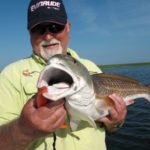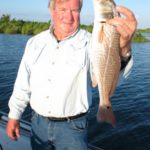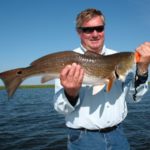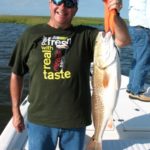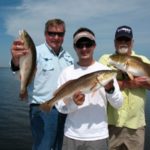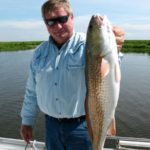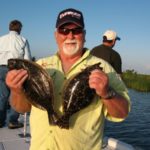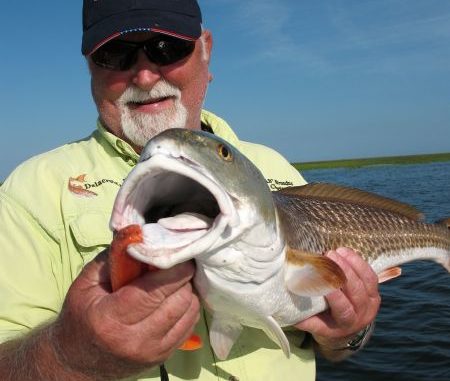
Trout anglers are at the mercy of Mother Nature, but the waters out of Delacroix are always teeming with redfish that are ready to pounce.
The winds were already blowing when I stepped out of my truck onto the dock by Capt. Ron “Ahab” Broadus’ boat dock down in Delacroix Island.
The early morning bluster was proving the forecasters wrong again: They’d predicted light winds and calm seas.
One step on the dock and I knew it’d be a redfish kind of day. At least the tide range was good and there was enough water to get up in the interior marsh where the bronze-backs like to forage.
Broadus introduced my brother Tony and me to his longtime friend and fellow charter captain, Mike Wittich, and to a young captain-in-the making, Ryan Schaffino. The five of us climbed aboard Broadus’ 25-foot Gator Bay Boat, and its 250-horsepower Evinrude pushed us down the bayou to Serigne’s Marina to stock up the baitwell with live shrimp.
That done, Broadus pointed the bow down Bayou Gentilly toward Little Lake and beyond.
Broadus’ nickname “Ahab” might seem like an odd name for a charter guide. It’s a moniker his ex called him, complaining that he was as obsessed with fishing as Moby Dick’s Capt. Ahab was with finding the white whale.
He said the ex is long gone but the nickname stuck.
“My game plan for today is simple, and typical of my September routine,” Broadus said as we zipped past the broken marsh. “I’ll head toward the fringe bays, the larger lakes and bays on the fringes of the outside waters.
“My original plan was to head into Black Bay and fish around the usual summer hotspots for some trout, and then stop and hit some redfish spots on the way in, but this stiff wind is making me adjust and focus entirely on reds. Sometimes you just have to go with what nature throws at you.
“And my motto is you ought to eat more red meat anyway.”
Even though I grew up fishing the Delacroix marsh and I absolutely love to fish it, I just don’t get to do it as much as I’d like.
And the marsh has dramatically changed since Katrina and last year’s Isaac. Many of the meandering bayous and canals I used to follow are open water now and unrecognizable, and places I should have recognized I didn’t.
Broadus soon had me lost and confused, and I repeatedly had to ask him where we were, hoping I’d see something recognizable to spark my memory.
“This is Lake John,” Broadus announced as he slowed the boat to a quiet crawl. “I’ve been having some success in here up against the shorelines at cuts and coves and points, so we’ll take a few minutes and see if the reds are still in here.”
The Power-Pole lowered and stuck us fast within casting distance of a broken shoreline.
Broadus and Wittich stuck live shrimp under corks and tossed them against the grassy shoreline, while Schaffino tight-lined a purple/chartreuse soft plastic cocohoe. Tony fished a Vudu shrimp under a cork, and before I could decide what to throw we had our first and second redfish on the line.
Schaffino caught a slightly undersized red on his plastic cocohoe, so he quickly unhooked and released it, and Wittich reeled in a keeper — a nice eating-sized red that he swung aboard, giving me a look at his unusual rig.
Having fished for 20 years with everyone from seasoned anglers to longtime charter guides, I still find it interesting how many different rigs people use successfully to catch fish. And the rig Wittich used was different enough to catch my attention. See the sidebar to learn more about his outfit.
Broadus said September is typically a transition month for trout, meaning they begin their annual migration back from the outside waters toward the inside marsh. But our weather has been atypical, so if the warm weather continues and no real cool fronts blow down you’ll be able to fish for trout this month just like you did in August — outside and deep at rigs and wells, or shallow under corks at islands and reefs.
“I look back on my records over the last couple years and I see where I still made many trips to the outside waters — Black Bay and Breton Sound — in September,” Broadus said. “And those trips were productive. I’ll do the same thing again this year if the weather is summer-like.
“On any day with calm-enough winds, I’ll head straight out for trout and hit the islands and rigs, and I’ll be sure to have live shrimp in the baitwell.”
Wittich said he’ll begin to target trout in the fringe lakes like Lake Campo, Pato Cabello and Bay Lafourche, focusing mostly at points and coves, where live shrimp will entice both trout and reds.
“I look for good clean water, a moving tide and signs of bait in the water,” he said. “Find that and fish there.”
Broadus added that reds are usually on patrol along the shorelines of the fringe bays.
“I can usually catch reds on the fringes all year round — any month of the year,” he said. “But beginning this month and moving into fall, the redfish will start to stack up deep in the interior marsh, and if you only want to chase reds that’ll be your best option.
“Forget about heading outside. Head straight into the interior marsh and focus on redfish, and you won’t even need live shrimp. Market bait is good enough if you want to hang some stink on a hook; otherwise, you can fish soft plastics, spinners and spoons.”
Broadus was correct, and the reds were definitely stacked up in Lake John. We worked along a section of shoreline and caught fish after fish. Most weren’t huge, but they were the perfect grilling size, and everybody aboard caught their share.
I noticed that the reds, except for a few smaller fish that took the baits but were an inch or more undersized, mostly ignored our plastics. For the most part, it was the live shrimp that enticed them to bite, and we managed to put a few nice flounder in the ice chest, as well, before we moved farther toward the fringe bays.
“Since we won’t be chasing trout today, let’s head out toward Lake Campo and see if we can find some bigger reds,” Broadus said.
So, we did. And, we did.
We bounced around, trying a few spots until Broadus found an area where the water was pretty and the tide made a good-looking current line around a point.
The reds were there.
We put a couple nice fish in the boat and released another over 27 inches before pulling up again, this time to head into the deep interior. Broadus said he had a few spots in Little Lake and Grand Lake he wanted to try before we pulled the plug and called it a day, so off we went.
“Basically, I have two methods I follow this month,” he said. “Naturally, a lot depends on the weather, and a lot depends on the crew I’m taking fishing.
“If I’m taking inexperienced anglers, then I’ll anchor off at points and at some promising-looking areas of broken grass along a shoreline, and I’ll have them fish live or market shrimp 18 to 20 inches under a popping cork. Mostly I’ll try to stay in areas without a lot of grass, so fringe bays and mid-area lakes and bays are good spots. Parts of Little Lake, off Bayou Fongera, parts of Lake John and those areas out around Lake Campo are good bets.
“Just find a good point, clean water and current, and if you see bait in the water, that’s a no-brainer — fish that spot.”
But he doesn’t waste too much time at any individual location.
“I give a spot at least 15 minutes or so to produce, but you have to know when to quit a spot and move elsewhere,” Broadus said. “You can’t afford to waste time camping out at an unproductive spot.”
The strategy changes if his crew really knows what they’re doing.
“But if I have more-experienced anglers — some who can cast and retrieve — then I’ll fish the deep interior, Lake Batola, Grand Lake, and I’ll try to find areas with grass and we’ll slowly troll and cast and retrieve along the edges of the grass,” Broadus said. “Weedless gold spoons are great baits for this kind of fishing, and I like beetle spins and soft plastics.
“If I’m fishing plastic, I’ll use either a Deadly Dudley in the slammin Sammy color or a Bayou Chub in purple/chartreuse or black/chartreuse on a ¼-ounce jighead. If the water is real clear I’ll use a bait in the opening night/chartreuse color.”
Broadus doesn’t sink his Power-Pole, however.
“I love to troll along the grass edges and cast and retrieve because we catch both reds and bass and occasionally trout like that, especially later in the month and on toward fall,” he said.
We picked up fish at almost all the lakes we fished. Not every spot had fish, but by trolling along a shoreline or hopping from point to point, we put a nice box of fish together.
“It’s something any angler can duplicate this month,” Broadus said. “If you’re a small-boat angler, I’d forget about chasing trout this month and head straight into Delacroix’s deep interior marsh and fish for reds. Don’t worry at all about live bait — just spoons, spinners, soft plastics and maybe some market shrimp, just in case you get desperate.
“Bigger-boat anglers can head outside and try to find some trout in the morning and leave yourself some time to fish for some redfish in the fringe bays on the way in. That way you get the best of both worlds: trout in the morning and reds before noon.”
Editor’s Note: Capt. Ron “Ahab” Broadus can be reached at 504-914-6063.
